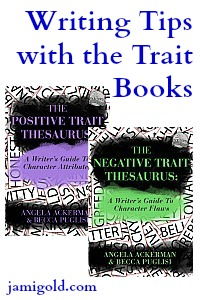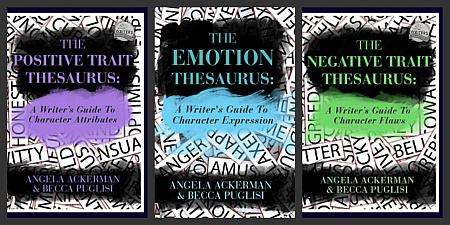I have a special treat for everyone today! I’ve mentioned many times that I love The Emotion Thesaurus by Angela Ackerman and Becca Puglisi (of The Bookshelf Muse/Writers Helping Writers fame) for expanding my “showing vocabulary” when it comes to character emotions.
A few weeks ago, I shared how their new books, The Positive Trait Thesaurus and The Negative Trait Thesaurus, contained tons of new character development tips that I’ll definitely be using for character creation. But I wondered if the new books could be used during the drafting or editing stages too, like how I use the ET on a near-daily basis.
Angela and Becca answered my call for help, and Becca is here today to share her tips for how to use the two Trait Thesauri books during all stages of writing, not just for character creation. (*psst* This is a long post, but a keeper—and read all the way through for a giveaway.) Please welcome Becca Puglisi!
*****
Using the Positive and Negative Trait Thesauri during Drafting and Revision
First off, let me start with a great big pom-pom shake for all the NaNo’ers out there! I’ve always wanted to participate, but since November is a terrible month for me, I’ve decided to do my own NaNo in January. I’m super excited to work on my story idea, one that started with the good ol’ What If? scenario.
My stories are, without exception, plot driven. And yet, as a reader, it’s not the plot that holds my interest. It’s the characters.
This is why I believe that for a story to succeed, you’ve got to get the characters right. For readers to connect, the characters have to be believable, relatable, and consistent.
This is one of the reasons Angela and I chose to follow up The Emotion Thesaurus with a resource on character traits. Our books, The Positive Trait Thesaurus: A Writer’s Guide to Character Attributes and The Negative Trait Thesaurus: A Writer’s Guide to Character Flaws, are geared to help writers build strong, realistic characters.
These books can be quite helpful in the creating and outlining stage; this post from Davonne Burns is a great tutorial on how to use them to create characters during the planning process. But these resources can also be helpful during the drafting and revision stages.
So if you’ve started a story—or even finished one—and you realize that you need to beef up your characters, I’d like to share some tips on how to use The Negative and Positive Trait Thesauri to get the job done. For clarity, I’ve included a partial excerpt from the the Negative Trait volume at the end of the post for the extravagant trait. (Pssst: The fields referenced below can be found in the entries of both books.)
During the Drafting Stage
- Build CONSISTENCY by using the Associated Behaviors and Attitudes field.
This field contains an array of possible actions and reactions that might make sense for your character. Take extravagance, for example, from The Negative Trait Thesaurus. Associated behaviors and attitudes for an extravagant character may include lying to cover one’s expenditures, scorning money-saving methods, not taking care of one’s possessions, or being ignorant of how others live.
Tip: As a brainstorming tool, this field can help you come up with sensible actions for your extravagant character so you can paint a consistent picture of her personality.
- Add INSIGHT by using the Associated Thoughts field.
Characters aren’t always forthcoming. They often try to hide their flaws or even their positive attributes from others. It can be challenging for us to show our characters’ true traits when they’re working so hard to keep them hidden. Thoughts, though, are unfiltered; they’re a great way to reveal to the reader who the character truly is.
Tip: Use this field to brainstorm thoughts that can add contrast to behavior and clarify for the reader who the character really is in his heart of hearts.
- Add CONFLICT by introducing characters who clash (refer to the Traits In Supporting Characters That May Cause Conflict field).
Conflict is absolutely pivotal to a successful story; it’s one of the things that keep readers turning pages. One great way to add tension is to introduce characters whose traits conflict with the hero’s.
Tip: If you know your hero’s defining trait, consult the associated Traits In Supporting Characters That May Cause Conflict field to see which flaws and attributes may create the most fireworks.
During the Revision Stage
If you’re anything like me, once you’ve reached the revision process, you’ll begin to notice some issues with your character that need addressing. The Trait Thesauri can be a big help in fixing some of these common problems.
- Add DEPTH to flat characters with the Negative and Positive Aspects fields.
Characters are rarely all good or all bad. Flaws have positive traits associated with them, and positive attributes can have negative elements. Tap into both the positive and negative sides of your character’s defining trait to add depth.
In the Positive Aspects field of the extravagant entry, we see that characters with this flaw are often generous; they’re frequently involved in fun and exciting events (like parties and expensive trips) that can add interest to your storyline; these characters can be highly social, life-of-the-party types, which may draw others to them.
Tip: To add layers to a flat character, explore both sides of his defining traits—the positives and the negatives—and you’ll add depth without sacrificing consistency.
- Make sure your character has a FLAW to overcome (refer to the Overcoming This Trait As A Major Flaw field).
While much of your character’s conflict will come from external sources, an internal conflict will add interest to readers, because while most of them haven’t had to defeat a dragon or dismantle a bomb, readers understand flaws and the struggle to master them. To increase the possibility of readers connecting with your character, consult The Negative Trait Thesaurus and choose a flaw that makes sense—one that the hero must overcome by the end of the story.
Tip: If you’re not sure how to help him defeat that flaw, the Overcoming This Trait As A Major Flaw field (which is only found in the Negative Trait volume) can give you some ideas.
- Add ENVIABLE or LIKABLE traits to increase reader empathy with The Positive Trait Thesaurus.
While characters need to be flawed, they also need to be likable, admirable, or intriguing in some way. Traits like intelligence, wittiness, courage, and loyalty are largely admired and will resonate with readers.
This is where The Positive Trait Thesaurus comes into play. Look for qualities that make sense for your character and add them to her personality.
Tip: These positive attributes will smooth out the rough edges of your character’s flaws and increase the chances of endearing the reader to her.
- Make your character more REALISTIC by understanding why he is the way he is (refer to the Possible Causes field).
Some authors make the mistake of randomly assigning traits without having a clear idea of why their characters embody these qualities. Attributes and flaws don’t just spontaneously appear; they form out of past factors. Environment, genetics, role models and peers, wounding events—all of these determine which traits a character will exhibit. If you’re not sure why your extravagant character is the way he is, check out the Possible Causes field of that entry for some ideas, then dig deeper.
One of the causes listed is “wanting to impress others.” Ok. Why does he have this need? Maybe it’s because he grew up in a family of overachievers who always stole the limelight. Maybe by throwing his money around, he gains the attention that he never received growing up.
Another possible cause: “the inability to say No to loved ones.” Why does this drive him? What happened in his past that makes it so hard for him to simply say No?
Traits don’t exist in seclusion. They emerge due to events and influences from our past.
Tip: Figure out why your character is the way he is, and you’ll be able to write him in a believable fashion.
I could write more on this subject, but it’s time to wrap things up. Angela and I have learned so much from the writing of these books. We really believe that they can be helpful at all stages of the writing process, and I personally can’t wait to put what I’ve learned into practice on my next project. Best of luck!
*****
Sample (Partial) Entry from The Negative Trait Thesaurus: A Writer’s Guide to Character Flaws
EXTRAVAGANT
DEFINITION: exceeding the limits of sensibility or need
SIMILAR FLAWS: excessive, profligate, wasteful
POSSIBLE CAUSES:
Great wealth
Equating the appearance of wealth with self-worth
Wanting to impress others
Envy
Ignorance regarding the value of finite resources
Wanting to make others happy regardless of the cost to oneself; being overly generous
The inability to say No to loved ones
ASSOCIATED BEHAVIORS AND ATTITUDES:
Not keeping or not sticking to a budget
Letting someone else handle the finances
Being in financial debt; spending more money than one takes in
Throwing lavish parties
Spending large amounts of money on others
Not bothering with money-saving methods (coupons, choosing generic brands, etc.)
Not taking care of one’s possessions
Impulse buying, or purchasing things and then not using them
Throwing out perfectly good items
Taking expensive trips
Making excuses for one’s decisions
Lying to cover one’s extravagance
Paying with cash and throwing away receipts
Manipulating spouses, parents, and others to get them to buy what one wants
Being wasteful with other resources (water, electricity, time, etc.)
Ignorance about how others live
ASSOCIATED THOUGHTS:
I don’t need this but I have to have it. Money is no object.
I’ve earned a little spending spree.
ASSOCIATED EMOTIONS: anxiety, conflicted, defensiveness, denial, desire
POSITIVE ASPECTS: Many extravagant characters are truly generous at heart, wanting to share what they have to make others happy. Because of their willingness to spend money freely, they’re often involved in exciting activities: parties, vacations, shopping sprees, etc. This makes them life-of-the-party characters, and easily likable.
NEGATIVE ASPECTS: Though they might be popular, it is difficult for extravagant characters to tell true friends from scavengers. If there is an ulterior motive behind their wastefulness (insecurity, a desire to maintain appearances, etc.), they can easily fall victim to those willing to manipulate them. Resources are never infinite, and if extravagant characters aren’t careful, their waste can lead to financial ruin, affecting not only themselves but family members as well.
OVERCOMING THIS TRAIT AS A MAJOR FLAW: Extravagance is only desirable when one has resources to waste. When the resources run out, so must the wastefulness. But inconveniencing oneself isn’t always enough; characters can run into personal difficulty and still not change their extravagant ways. It’s more difficult to see one’s wastefulness affect loved ones in a drastic, traumatic way and not come away changed.
TRAITS IN SUPPORTING CHARACTERS THAT MAY CAUSE CONFLICT: cautious, jealous, resourceful, responsible, socially aware, stingy
*****
 Becca Puglisi is the co-creator of The Bookshelf Muse, an award winning online resource for writers. She has also authored a number of nonfiction resource books for writers, including The Emotion Thesaurus: A Writer’s Guide to Character Emotion; The Positive Trait Thesaurus: A Writer’s Guide to Character Attributes; and The Negative Trait Thesaurus: A Writer’s Guide to Character Flaws. A member of SCBWI, she leads workshops at regional conferences, teaches webinars through WANA International, and can be found online at her Writers Helping Writers website.
Becca Puglisi is the co-creator of The Bookshelf Muse, an award winning online resource for writers. She has also authored a number of nonfiction resource books for writers, including The Emotion Thesaurus: A Writer’s Guide to Character Emotion; The Positive Trait Thesaurus: A Writer’s Guide to Character Attributes; and The Negative Trait Thesaurus: A Writer’s Guide to Character Flaws. A member of SCBWI, she leads workshops at regional conferences, teaches webinars through WANA International, and can be found online at her Writers Helping Writers website.
*****
Wow! Fantastic information, Becca. I can’t wait to try out these techniques. I love the DEPTH tip of using the Positive Aspects of a negative trait to show both sides with consistency. Thank you so much for sharing!
Now as promised, Becca will also be giving a PDF copy of one of the new Trait Thesauri (winner’s choice) to one commenter. To enter, just leave a comment before 5:00 Eastern Time on Wednesday, November 27, 2013.
Have you used the Positive or Negative Trait Thesauri yet? Did you use them just for character creation, or do you have other tips for using them during drafting or revision? What’s your favorite tip of Becca’s? Do you have any questions for Becca? If you win the giveaway, do you know which Trait Thesaurus you would want?


